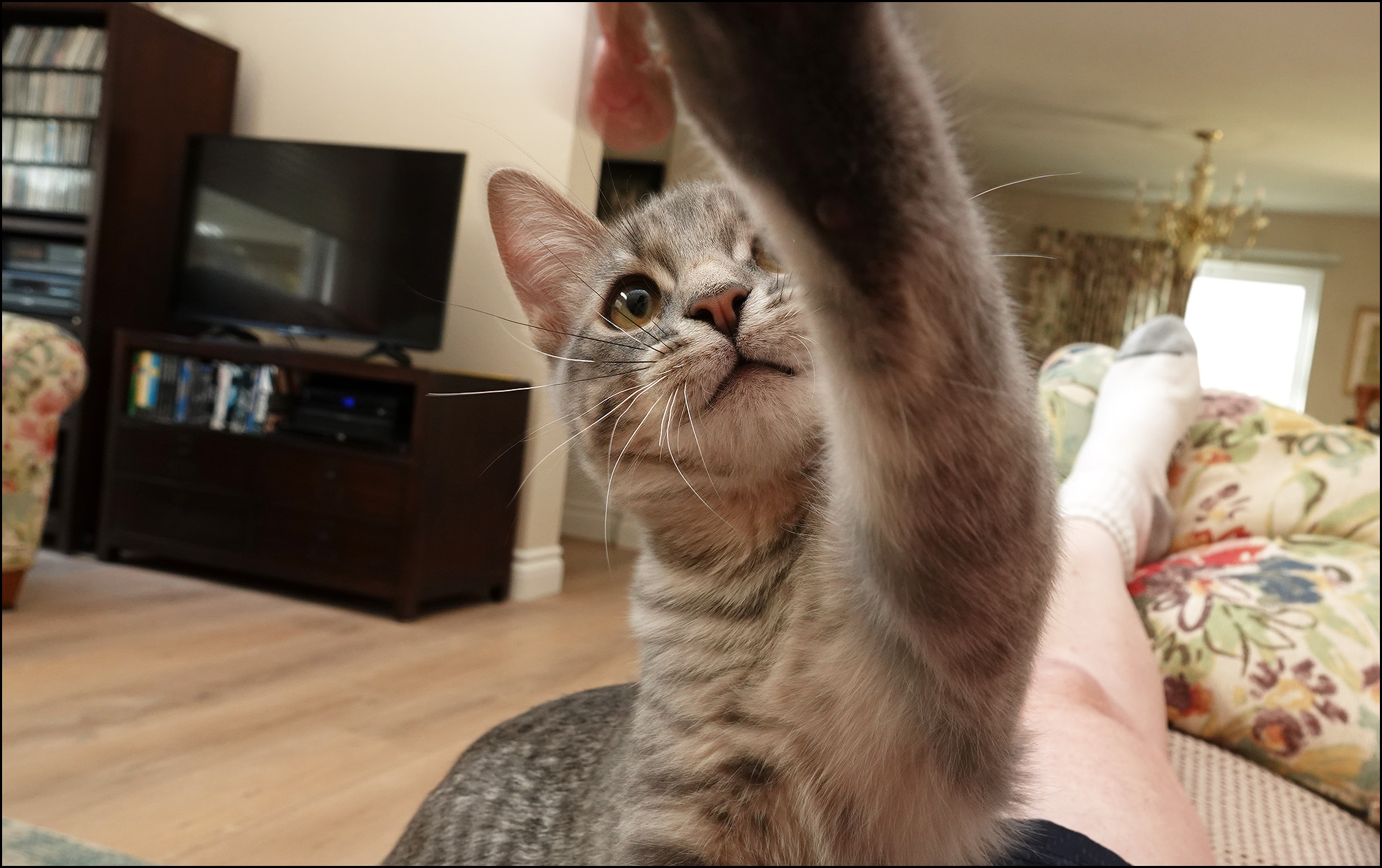I've always hated flash photography, and the era of the iPhone has only intensified my feelings. All those flat, overexposed, artificially sharp faces drive me bananas. The last time I personally owned a flash unit was in high school.
But now I have a problem. We don't allow Charlie outside, which means I have to take indoor pictures of him. And this is not like taking a picture of a cathedral or something similar, where I can put the camera on a tripod. This is action photography! Unfortunately, the ambient light in my house—like all houses—is lousy because it's dim and it's all overhead. Cats move around a lot, which means pictures are often blurred and shadowy.
So I need a flash unit. The problem is that the light from a flash unit is collimated, which is why flash pictures look unnaturally sharp when the flash is pointed directly at the subject. It's also what produces sharp shadows in the background. The answer is an external flash unit with a bounce head. With the flash aimed at the ceiling and the light bouncing around the room, illumination is even; faces are properly exposed; and shadows are soft.
So that's what I got. The one I chose arrived defective, which seemed like a bad omen, so I returned it and went out to my local camera store and bought whatever they recommended. As it turned out, they only had one that was suitable for my needs, so that's what they recommended.
And it works fine. Here is Charlie, captured via a Godox V1 with a bounce head.





Fabulous photos. Charlie is getting so big. But what is Marian reading????
Charlie looks like a close cousin to the new White House cat, Willow.
Kevin should get one of those huge cameras with the giant flash on it newspaper photographers lugged about in the 1940s, like WeeGee, or in Raging Bull.
Wee Raging Charlie could be a great movie.
Really nice results. Probably should get the Godox accessory pack (if you haven't already) especially for the bounce flash accessory, to throw some light forward to fill in shadows under eyes (for people more than cats). An index card plus rubber band should also work and cost less. I would have thought that any Sony compatible flash would work, but Godox V1 certainly has a whole lot of power.
I use a mini-softbox on mine. The big-ass Godox units are pretty nice flashes for a reasonable price.
Very nice pictures. Even though I mostly avoid using a flash in my humble photographic experience, I never thought about there being never-flash photographers out there.
My dad was never flash. I dont think I have run across one indoor photo yet.
Oh wait, he bought a polaroid for that purpose in the 80s.
I really hope you'll get the gizmo called a "flash commander" that sits on top of your camera (in the hot shoe, where the external flash itself would normally sit) and allows you to "fire" the flash remotely. In other words -- as you probably know, but for the benefit of anyone else listening -- you can then put the flash anywhere you want and avoid the harsh direct look. In fact, you can have a lot of fun and get some interesting effects putting it off to the side of the camera and lighting your subjects from the side etc. I believe the Godox flash commander is pretty cheap, but you'll have to check that it works with your flash.
It does work. The Godox system is pretty comprehensive. My brother has 3 of them and a trigger unit (what you call a commander).
Great shots. Charlie and Willow are just like my old cat. Beautiful.
But where are the pictures of Hilbert unpacking his Acme Rid-a-Cat Catapult Deluxe?
Or does he stand in the doorway and put one foot back and forth on both sides while saying, “I can step out. I can step in.”
But who needs to be an outdoor cat when you fill use of The Marian?
Nice shots…that Charlie looks like he’s made himself right at home
Before digital, a good way to get acceptable, and sometimes even intriguing, candid shots was to use a substantially longer exposure than the the standard 1/60 second synchronization shutter speed that was typical of SLRs with focal-plane shutters. That standard speed was really just the shortest exposure that allowed light from the lens to hit the film over the entire frame simultaneously -- anything shorter would have resulted in a part of the image being blocked by the shutter during the flash -- but a lot of people just assumed (incorrectly) that that was the only speed available when using flash.
By using a longer shutter speed in the range of 1/4 to 1/15 (or sometimes longer), that allows additional ambient light to get captured from the more distant background, which usually gets inadequately lit by a camera flash anyway and appears like a black void in the final shot. Obviously, the longer exposure also increases the likelihood of blurred movement, but the extremely short duration of the flash will reliably "freeze" the motion of the primary subject, usually resulting in a nicely rendered subject against a somewhat blurred, but filled-in background. The blurriness often even adds to the dynamism of the final shot.